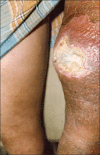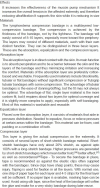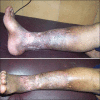Compression therapy for ulcers: The science and the art
- PMID: 23162227
- PMCID: PMC3495378
- DOI: 10.4103/0970-0358.101296
Compression therapy for ulcers: The science and the art
Abstract
Introduction: Chronic ulcers are characterized by being resistant to all forms of treatment. Recent improvement in compression techniques, notably use of multilayer bandaging has created a need for a re-look into it's use.
Materials and methods: The authors present two case reports of successful management of chronic ulcers using compression through bandaging where all other forms of treatment had failed. This is followed by a review of literature based on previous articles as well as more recent ones found through Pubmed.
Conclusion: It is suggested that, at least in India, compression through proper multilayer bandaging, should be a choice far higher in the treatment ladder than so previously. However, if the technique is improper, it may be harmful so the option is to be exercised with care and only by those who have received adequate training. The need of a team approach, and alongside, wider introduction of more and better training facilities for therapists and nurses is underlined.
Keywords: Chronic ulcers; compression therapy; lymphoedema; multilayer bandaging.
Conflict of interest statement
Figures








Similar articles
-
Maggots as a wound debridement agent for chronic venous leg ulcers under graduated compression bandages: A randomised controlled trial.Phlebology. 2015 Dec;30(10):693-9. doi: 10.1177/0268355514555386. Epub 2014 Oct 8. Phlebology. 2015. PMID: 25300315 Clinical Trial.
-
A randomized trial of the Tubulcus multilayer bandaging system in the treatment of extensive venous ulcers.J Vasc Surg. 2007 Oct;46(4):750-5. doi: 10.1016/j.jvs.2007.04.062. Epub 2007 Aug 30. J Vasc Surg. 2007. PMID: 17764879 Clinical Trial.
-
Compression bandaging for venous leg ulcers: the essentialness of a willing patient.J Clin Nurs. 2008 Feb;17(3):350-9. doi: 10.1111/j.1365-2702.2007.01996.x. J Clin Nurs. 2008. PMID: 18205691
-
Effect of different compression bandaging techniques on the healing rate of venous leg ulcers: a literature review.Br J Community Nurs. 2020 Jun 2;25(Sup6):S20-S26. doi: 10.12968/bjcn.2020.25.Sup6.S20. Br J Community Nurs. 2020. PMID: 32501762 Review.
-
How effective is training in compression bandaging techniques?Br J Community Nurs. 2003 Feb;8(2):80-4. doi: 10.12968/bjcn.2003.8.2.11091. Br J Community Nurs. 2003. PMID: 12589249 Review.
References
-
- Briggs M, Closs SJ. The prevalence of leg ulceration: A review of the literature. Eur Wound Management Assoc J. 2003;3:14–20.
-
- Ryan TM. Wound healing in the developing world. In: Macdonald JM, Geyer MJ, editors. Wound and Lymphoedema Management. World Health Organization; 2010. pp. 3–7.
-
- Williams NH, Bulstrode CJ, O’Connel P, editors. Bailey and Love's Short Practice of Surgery. 25th ed. Publisher Hodder Arnold; 2008. p. 935.
-
- Blume PA, Walters J, Payne W, Ayala J, Lantis J. Comparison of negative pressure wound therapy using vacuum-assisted closure with advanced moist wound therapy in the treatment of diabetic foot ulcers: A multicenter randomized controlled trial. Diabetes Care. 2008;31:631–6. - PubMed
-
- O’Meara S, Cullum N, Majid M, Sheldon T. Systematic reviews of wound care management: (3) antimicrobial agents for chronic wounds; (4) diabetic foot ulceration. Health Technol Assess. 2000;4:1–237. - PubMed
LinkOut - more resources
Full Text Sources

